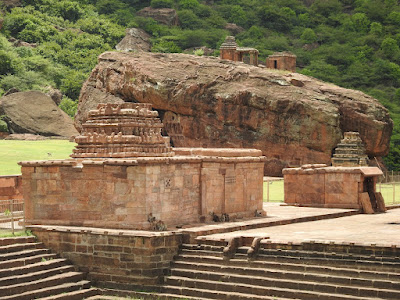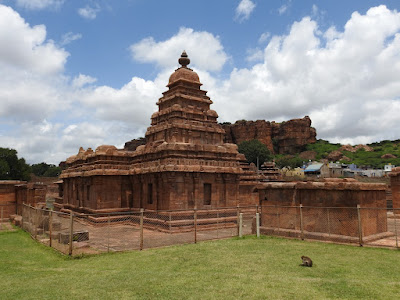Right besides Bhootnath group is this huge sandstone boulder on which relief sculptures are present.
On the northern face are four Shivalinga, two of the Shivalinga have their own Nandi.
Closer look at the sculptures. Shivalingas are housed in Garbhagudi, complete with Shikhara.
Another view of the northern face. On the extreme left is an image of four-armed standing Vishnu.
As we go around the rock formation, a natural shelter is seen. The rock faces under the overhang are filled with sculptures of Hindu gods.
There are two rows; the lower row consists of ten male characters in seated position, mostly in meditative position. Most of the images have been damaged, seemingly an intentional act of vandalism. The upper row, left to right, has Boovaraha, Ganapati, Brahma, Maheshwara, Vishnu, Mahishamarshini and Ugranarasimha. To the extreme right is a Shivalinga inside a Garbhagudi. Each of the characters have an arch, probably incomplete arches. Just above the arches are inscriptions of signatures in Kannada. I guess those are sculptors' banes. Over the inscriptions are seven square holes, five small and two large. It's my guess those are meant for placing oil lamps.

On the other face under the overhang are three images; one complete and two incomplete. On the left is Shivalinga inside Garbhagudi; in the middle is standing Vishnu with incomplete housing; and to the right is an image in very early stages. For some reason work was abandoned. On the lower part of the face is a small Shivalinga. Further lower and to the left is a square outline. Looks like that's another incomplete Shivalinga.
As we go around the boulder to the opposite side. a small structural temple is present. The temple has been built in a very tight space. From here it looks as though a cube has been pushed into the boulder.
On the left of the footpath is a boulder with natural slits. The lower slit which is open to sky catches rainwater. The ancient sculptors made a narrow groove to funnel out water. The boulder isn't large enough to hold water to sustain a flow lasting more than an hour. Maybe it lasted more than what I ca imagine.
Caretakers have maintained a neat lawn and flowering plants here. The pink Oleanders and green leaves enhance the place's charm.
Another look at the squeezed in temple. The more I look at this temple, the more I admire the clever idea.
This seems to be another incomplete rock-cut shrine. Not sure is this was meant to be a rock-cut shrine or a combination of rock-cut and structural temple.
View of the spot from an elevated spot.
This is my friend Srini from Hyderabad. Srinu and I were on a two-day tour of Badami, Pattadakal and Aihole. Our tour had started from the four cave temples. Then we drove around to the North fort side. We had done quite a bit of walking under the blazing sunlight. We took a short break while it was partly cloudy. This waterbody is home to water fowls and other water birds.
At a distance was a flock of cormorants resting on rocks amidst the waters. Cormorants are good fliers and swimmers. With their webbed feet, they swim well on the surface and even underwater. The way they take from water is a sight to behold.
Turning back the sandstone formations, I noticed a unique feature here. On the surface were irregular lines which looked like dried sticky matter.
On the lower part of this picture, there are bands of lighter shades. Amazing how this texture came into being. Sandstone, a sedimentary rock, is formed when grains of quartz or feldspar are held together under pressure for millions of years. During the process other minerals too get trapped and remain embedded in sandstones.
A closer look at the dripping and sliding lines. Is it possible that some matter were squeezed out under pressure, like concrete escaping through gaps of centering plates.
Lastly, at the end of Bhootnath group enclosure is a rock-cut cave shrine known as Vishnu Gudi. Inside that cave temple are several images, the chief image being that of Anantashayana. We'll see Vishnu Gudi in detail in the following post.

In the above picture, on the left hand side are two incomplete images. Once is Ganapati for sure. The other image could be meant to be Vishnu. Having written this post, I feel I must visit Bhootnath group again and catch up with missed out sculptures.
.........























































